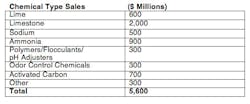Chemical Sales for Air Pollution Control To Exceed $5.6 Bil. in 2012
Sales of chemicals to reduce air pollution from stationary sources will exceed $5.6 billion in 2012, an 8 percent increase from 2011, according to the latest forecast in the Air Pollution Management report by McIlvaine Company.
The report says sales of activated carbon are now projected at $700 million. This is a lower adjustment from previous forecasts.
The biggest use of ammonia is for reduction of nitrogen oxides. The sales figure of $900 million for 2012 is just for stationary source emissions. There is also a significant mobile market, the report says. Ammonia is also used as a scrubber reagent. A byproduct is ammonium sulfate. The sales price of the byproduct is now four times the price of the purchased ammonia, so there is an economic advantage to using this reagent, the report states. However, the problem is that a blue plume is generated and a wet electrostatic precipitator is often needed to eliminate the fine ammonium chloride or sulfide particles.
Most scrubber systems are equipped with wastewater treatment equipment. This involves the use of various chemicals including polymers flocculants, and pH adjusters. A variety of odor control chemicals, including hydrogen peroxide, potassium permanganate, and others, are used in scrubbers located in municipal wastewater treatment, chemical, food and beverage, and other manufacturing plants.
The market is growing at close to double digit-rates, according to the report. China is the largest purchaser of limestone for scrubbers and is the second largest purchaser of ammonia for NOx control. The U.S. remains the largest purchaser for the present but will lose this position by 2020.
For more information on McIlvaine’s Air Pollution Management report, click here.


